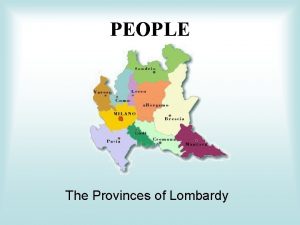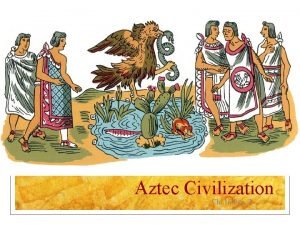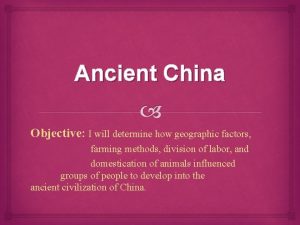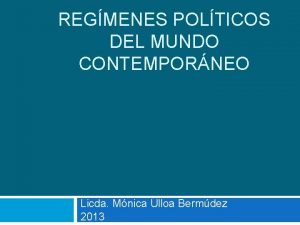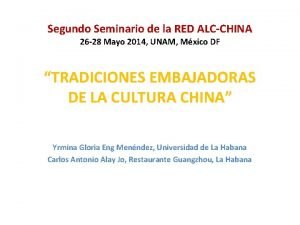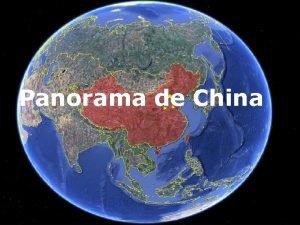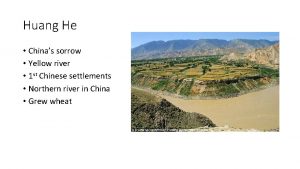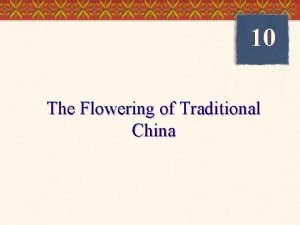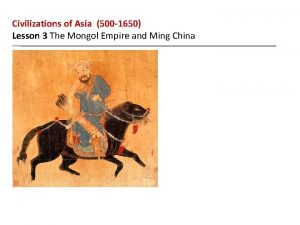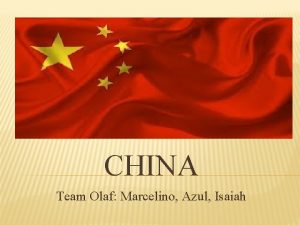CHINA he enormous in size 56 provinces in



























































































- Slides: 91




















Εργασίες μαθητών στα αγγλικά • CHINA • Τhe enormous in size 56 provinces in China show significant differences in their kitchens in both their materials and the way of cooking and preparation. Basically, however, the Chinese cuisine is divided into four major cuisines: In the kitchen of Beijing and North China Santogk. In the kitchen of Shanghai and east China. In Cantonese cuisine and South China. In the kitchen of Sichuan and West China. Northern China, including arid areas and vast pastures reach the steppes of Mongolia, the fertile valleys running through the Yellow River, the sea rich Yellow Sea and the tradition of the famous imperial cuisine of Beijing. The kitchen of the palace (Imperial Cuisine) has lost a big chunk of the techniques and materials of the dramatic simplification held immediately after the revolution. Dominant products are cereals, beans, tofu, herbs, vegetables (lettuce, Chinese cabbage, leeks, onions, reves) meat (lamb, pork), poultry (duck, chicken, pigeons) and plenty of fish in the rivers and the Yellow Sea. Dozens of kinds of pasta (noodles) which symbolize longevity and always shared among the guests. What is completely absent is rice, which is grown mainly in the southern provinces and Beijing will serve you if and only if you ask!. • •

BEIJING • • The most famous dish IN BEIJING A representative full meal in Beijing definitely includes eight starters and fourteen main courses. Of these at least ten are made only with vegetables. Among the appetizers and main dishes are always served different kinds of soups almost always transparent. Some dishes which will surely find even the simplest restaurants in Beijing are: 1. Braised Chinese leaves and straw with mushrooms. 2. Peking duck 3. Mu-shi pork (chopped pork with eggs and vegetables). 4. Sesame seed prawn toasts(shrimp).

• • • • 5. Chinese "hot" pot. 6. Sweet and sour fish. 7. Stir fried kidney flowers (pork with mushrooms, water chestnuts, spinach). 8. Seafood and asparagus soup. 9. Fish fillet in wine sauce. 10. Rapid fried lamb with leeks. 11. Stir-fried chicken slices with vegetables. 12. Noodles(with vegetables or meat and seafood). THE FIVE FLAVORS OF BALANCE Confucius in the 6 th century, along with the religious authorities set the framework for proper nutrition. All materials such as meat, fish, vegetables, fruits should be in season, cut evenly into very small pieces. A dinner in China necessarily required 5 different flavors: sweet, sour, spicy, bitter, salty. Sweet for example, is rice, sweet potatoes, spinach tart, spicy ginger, basil, turmeric and bitter salty rock salt and kelp. Also, the Chinese meal is characterized by: the cool (eggplant, tofu, bean sprouts), warm (leek, sunflower seeds), cold (water chestnuts, tomato, watermelon), hot (peppers, black pepper, ginger) and neutral ( Chinese cabbage, mushrooms, peanuts), not by the temperature at which is served, but the energy which is consumed. All these elements contribute to the essential function of five vital organs: liver, spleen, heart, lung and kidney. The challenge is to avoid violating the balance of two opposing forces, yin and yang, whose harmonious relationship strikes a balance not only in food but also in all things in the world of the Chinese. The cool, bitter and salty foods have more yin in nature, while the hot, sweet and spicy foods have more yang. In China many foods and whole meals are served (even indicated in the list) to treat or prevent certain diseases such as shells ampalon soup, chicken feet, beef and herbs or Tibetan wild chicken soup, lotus florets, Dried jujubes and herbs as well as shark fin soup.

• Strange • Animals, vegetables, fish, insects, reptiles and invertebrates that western cuisines feel exploited and nutritional taboos, are delicacies of the cuisine of China. • Here's a small list: shark fin soup, bird nests, snakes, sea starfish, jellyfish, sea cucumber (sea cucumbers), grasshoppers, centipedes, duck and chicken feet, pig ears, scorpions! • • The five basic ways of cooking. 1. The "sigomageirefta" with red sauce: cooked for 3 -4 hours in special earthenware without any water. By doing so they usually cook meat such as beef and beef along with vegetables and lots of soy sauce. 2. The Styria Fry (stir - fry), the favorite and well-known cosmopolitan cooking utensil wok. Substantially with a nonstick wok, they use minimum seed oil , place and fry quickly with continuous stirring slices or cubes of various materials, meat, seafood, fish and vegetables. An experienced Chinese cook can prepare such a dish in 2 -4 minutes!. 3. The famous hot pot that is boiling in clear broth: It's a slow way of cooking lamb mostly at very low temperature. It is a complete meal in itself. A large pot made of brass boiling with charcoal or gas usually arrives at the table full of water, seasoned with spices and with diced lamb. Everybody dives in the lamb pieces into the boiling broth. After cooking the meat in the broth, it should remain clear until the end, added various vegetables. 4. Steamed: open or covered pan. The materials, usually fish or small patties (dim sum) are placed in a basket made of bamboo, which is placed inside a steam kettle. 5. In Sao cha (cha shao) way of cooking they prepare usually meat or poultry previously marinated in soy sauce with lots of spices, garlic, ginger, chilli peppers. After hours of marinated meat cooked over high heat directly on the grill or wok.

• • • The cooking on the grill Behind the famous Square Tiananmen every evening around seven (the Chinese food served until 8: 30) staged a popular flea market with dozens of shops where everything is sold in minutes. The customer chooses from thousands of treats - for Europeans often unknown - like small jellyfish, snakes, starfish, grasshoppers, scorpions. Of course you can always choose more "conventional" foods such as lamb, chicken, pork, liver, squid, octopus, cuttlefish, crabs of all kinds of vegetables, smoked tofu. You just have to tend the index finger and the Chinese cook street will skewer sprinkled with a mixture of spices with plenty of pepper and cumin. You put it on fire or throw it into a pot of boiling oil and in less than two minutes you can enjoy it. Sweets in China are rare and probably the best you'll taste is fruit, strawberries, small apples, water chestnuts, kiwi fruit and even tomatoes that are originally passed in straws and after dipped in crunchy caramel. We recommend it highly!.

• • • Noodles: It is perhaps one of the most famous pasta in China and the world. There are dozens of shapes, thin, wide as tagliatelle, transparent and in colors green and yellow. Chinese wine (for cooking). Known as yellow wine made exclusively from rice mainly in Southeast China.

• • • • • SOME CHINESE MATERIALS. . . Soft cheese from soy (tofu). Shredded mashed and pureed soybeans extremely high in protein. Often sold cut into square pieces of 7. 5 cm and 2 cm. They are maintained for a few days if submerged in cold water and refrigerate. Chinese leaves. Known around the world as Chinese cabbage. Two are the most widely available varieties. The most common is a soft green with a tightly wrapped elongated head. Two thirds of cabbage is stalk having crispy texture. The other variety has a shorter head and thick with helical, pale yellow or green leaves, also with white stalk. Sauce Hoi Sin. Also known as a sauce for barbeque, made from soy beans, sugar, flour, vinegar, salt, garlic, chilli and sesame oil. Sold in cans or jars, kept in the refrigerator for several months. Plum sauce. A specialty of the Fujian in southeast China, plum sauce has a unique fruity flavor. Try it with spring rolls, roast meat or Peking duck. Water chestnuts. A bulb in the size of a walnut covered with brown skin. The flesh is white and crispy and has a delicate, sweet flavor. These are canned peeled, whole or sliced. Once opened you can keep them refrigerated up to 10 days. Sichuan pepper (Sichuan). Also known as «huajiao» . It is wild pepper from the area of Sichuan (Sichuan), very aromatic but less powerful than the white and the black pepper.

• • • • • • What we can find in the supermarket: Sauces Soy sauce Hoi Sin sauce Plum sauce Shrimp Sauce Fish sauce Yellow sauce and black beans Sweet and sour sauce Chili sauce Dried materials: Various mushrooms mainly Sitakis Black beans (Xian Tao) Rice leaves (for spring rolls) Noodles Canned Jars-Bottles: Red rice vinegar Rice wine Sesame Water chestnuts Lychee Bean sprouts Tofu Baby corn

• • • Vegetables and legumes: Garlic ginger green onions Chinese cabbage of Tien Tsin white radish (Dyck) moungk beans soy beans • THE END!!!!! • • • • DIRECTED BY: MARIOS MANTZOURAKIS & DIMITRIS SOUGLERIS & THOMAS GAVERAS

EATING HABITS IN ASIA ST’ CLASS SCHOOL YEAR 2012 -13


CHINA Τhe enormous in size 56 provinces in China show significant differences in their kitchens in both their materials and the way of cooking and preparation. Basically, however, the Chinese cuisine is divided into four major cuisines: • In the kitchen of Beijing and North China Santogk. • In the kitchen of Shanghai and east China. • In Cantonese cuisine and South China. • In the kitchen of Sichuan and West China. Northern China, including arid areas and vast pastures reach the steppes of Mongolia, the fertile valleys running through the Yellow River, the sea rich Yellow Sea and the tradition of the famous imperial cuisine of Beijing. The kitchen of the palace (Imperial Cuisine) has lost a big chunk of the techniques and materials of the dramatic simplification held immediately after the revolution. Dominant products are cereals, beans, tofu, herbs, vegetables (lettuce, Chinese cabbage, leeks, onions, reves) meat (lamb, pork), poultry (duck, chicken, pigeons) and plenty of fish in the rivers and the Yellow Sea. Dozens of kinds of pasta (noodles) which symbolize longevity and always shared among the guests. What is completely absent is rice, which is grown mainly in the southern provinces and Beijing will serve you if and only if you ask!.


The most famous dish IN BEIJING A representative full meal in Beijing definitely includes eight starters and fourteen main courses. Of these at least ten are made only with vegetables. Among the appetizers and main dishes are always served different kinds of soups almost always transparent. Some dishes which will surely find even the simplest restaurants in Beijing are: 1. Braised Chinese leaves and straw with mushrooms. 2. Peking duck 3. Mu-shi pork (chopped pork with eggs and vegetables). 4. Sesame seed prawn toasts(shrimp).

5. Chinese "hot" pot. 6. Sweet and sour fish. 7. Stir fried kidney flowers (pork with mushrooms, water chestnuts, spinach). 8. Seafood and asparagus soup. 9. Fish fillet in wine sauce. 10. Rapid fried lamb with leeks. 11. Stir-fried chicken slices with vegetables. 12. Noodles(with vegetables or meat and seafood

Peking duck



THE 5 FLAVORS OF BALANCE Confucius in the 6 th century, along with the religious authorities set the framework for proper nutrition. All materials such as meat, fish, vegetables, fruits should be in season, cut evenly into very small pieces. A dinner in China necessarily required 5 different flavors: sweet, sour, spicy, bitter, salty. Sweet for example, is rice, sweet potatoes, spinach tart, spicy ginger, basil, turmeric and bitter salty rock salt and kelp. Also, the Chinese meal is characterized by: the cool (eggplant, tofu, bean sprouts), warm (leek, sunflower seeds), cold (water chestnuts, tomato, watermelon), hot (peppers, black pepper, ginger) and neutral ( Chinese cabbage, mushrooms, peanuts), not by the temperature at which is served, but the energy which is consumed. All these elements contribute to the essential function of five vital organs: liver, spleen, heart, lung and kidney. The challenge is to avoid violating the balance of two opposing forces, yin and yang, whose harmonious relationship strikes a balance not only in food but also in all things in the world of the Chinese. The cool, bitter and salty foods have more yin in nature, while the hot, sweet and spicy foods have more yang. In China many foods and whole meals are served (even indicated in the list) to treat or prevent certain diseases such as shells ampalon soup, chicken feet, beef and herbs or Tibetan wild chicken soup, lotus florets, Dried jujubes and herbs as well as shark fin soup.


SOMETHING STRANGE… Animals, vegetables, fish, insects, reptiles and invertebrates that western cuisines feel exploited and nutritional taboos, are delicacies of the cuisine of China. Here's a small list: shark fin soup, bird nests, snakes, sea starfish, jellyfish, sea cucumber, grasshoppers, centipedes, duck and chicken feet, pig ears, scorpions!.



The 5 basic ways of cooking 1. The "sigomageirefta" with red sauce: cooked for 3 -4 hours in special earthenware 2. 3. 4. 5. without any water. By doing so they usually cook meat such as beef and beef along with vegetables and lots of soy sauce. The Styria Fry (stir - fry), the favorite and well-known cosmopolitan cooking utensil wok. Substantially with a nonstick wok, they use minimum seed oil , place and fry quickly with continuous stirring slices or cubes of various materials, meat, seafood, fish and vegetables. An experienced Chinese cook can prepare such a dish in 2 -4 minutes!. The famous hot pot that is boiling in clear broth: It's a slow way of cooking lamb mostly at very low temperature. It is a complete meal in itself. A large pot made of brass boiling with charcoal or gas usually arrives at the table full of water, seasoned with spices and with diced lamb. Everybody dives in the lamb pieces into the boiling broth. After cooking the meat in the broth, it should remain clear until the end, added various vegetables. Steamed: open or covered pan. The materials, usually fish or small patties (dim sum) are placed in a basket made of bamboo, which is placed inside a steam kettle. In Sao cha (cha shao) way of cooking they prepare usually meat or poultry previously marinated in soy sauce with lots of spices, garlic, ginger, chilli peppers. After hours of marinated meat cooked over high heat directly on the grill or wok.


Cooking on the grill • Behind the famous Square Tiananmen every evening around seven (the Chinese food served until 8: 30) staged a popular flea market with dozens of shops where everything is sold in minutes. The customer chooses from thousands of treats - for Europeans often unknown - like small jellyfish, snakes, starfish, grasshoppers, scorpions. Of course you can always choose more "conventional" foods such as lamb, chicken, pork, liver, squid, octopus, cuttlefish, crabs of all kinds of vegetables, smoked tofu. You just have to tend the index finger and the Chinese cook street will skewer sprinkled with a mixture of spices with plenty of pepper and cumin. You put it on fire or throw it into a pot of boiling oil and in less than two minutes you can enjoy it. • Sweets in China are rare and probably the best you'll taste is fruit, strawberries, small apples, water chestnuts, kiwi fruit and even tomatoes that are originally passed in straws and after dipped in crunchy caramel. We recommend it highly!.

Some chinese materials… Soft cheese from soy (tofu). Shredded mashed and pureed soybeans extremely high in protein. Often sold cut into square pieces of 7. 5 cm and 2 cm. They are maintained for a few days if submerged in cold water and refrigerate. Chinese leaves. Known around the world as Chinese cabbage. Two are the most widely available varieties. The most common is a soft green with a tightly wrapped elongated head. Two thirds of cabbage is stalk having crispy texture. The other variety has a shorter head and thick with helical, pale yellow or green leaves, also with white stalk. Sauce Hoi Sin. Also known as a sauce for barbeque, made from soy beans, sugar, flour, vinegar, salt, garlic, chilli and sesame oil. Sold in cans or jars, kept in the refrigerator for several months. Plum sauce. A specialty of the Fujian in southeast China, plum sauce has a unique fruity flavor. Try it with spring rolls, roast meat or Peking duck.

Water chestnuts. A bulb in the size of a walnut covered with brown skin. The flesh is white and crispy and has a delicate, sweet flavor. These are canned peeled, whole or sliced. Once opened you can keep them refrigerated up to 10 days. Sichuan pepper (Sichuan). Also known as «huajiao» . It is wild pepper from the area of Sichuan (Sichuan), very aromatic but less powerful than the white and the black pepper. Noodles: It is perhaps one of the most famous pasta in China and the world. There are dozens of shapes, thin, wide as tagliatelle, transparent and in colors green and yellow. Chinese wine (for cooking). Known as yellow wine made exclusively from rice mainly in Southeast China.


What we can find in supermarkets • • • • • • • • Sauces Soy sauce Hoi Sin sauce Plum sauce Shrimp Sauce Fish sauce Yellow sauce and black beans Sweet and sour sauce Chili sauce Dried materials: Various mushrooms mainly Sitakis Black beans (Xian Tao) Rice leaves (for spring rolls) Noodles Canned Jars-Bottles: Red rice vinegar Rice wine Sesame Water chestnuts Lychee Bean sprouts Tofu Baby corn Vegetables and legumes: Garlic ginger green onions Chinese cabbage of Tien Tsin white radish (Dyck) moungk beans soy beans

THE END DIRECTED BY: MARIOS MANTZOURAKIS & DIMITRIS SOUGLERIS & THOMAS GAVERAS

Eating Habits of America is not just USA. It is and a lot of other countries with their different culture. And as much the culture differ, so much do their eating habits!

North & Central America • USA, Mexico, Cuba and Guatemala

: A S U If you compare the eating habits of Americans with Italians, you will see that they have quite different styles. The fact is that Americans are not used to one typical single cuisine, like Italians. Their food consists of a mix of variety of foods from around the world. You will easily come across Mexican, Italian and Chinese restaurants all across America and situated next to one another. Americans do not have any deep-rooted cooking culture like Italians. One might as well profess that the most unique and typical American food is the junk and fast food types, coupled with soft drinks. Fast foods usually consumed by Americans are fast to prepare, cheap and tasty. But these are also high in fat, sodium, calories, sugar and cholesterol. Some of the negative and expensive heath results are obesity, heart disease, high cholesterol and cancer. For example, Mc. Donald's is a major symbol of the United States lifestyle and culture. In fact, the idea of a fast restaurant meal has completely changed eating habits and referred to as Mc. Donaldization. Almost a generation ago, close to three quarters of meals eaten by Americans were home made, but these days more and more number of people prefer fast food restaurants to home made food; mainly because its quick, cheap and tasty, and American families do not have enough time to cook up a full meal at home.

Mexico: Mexicans drink lots of milk, like salty foods more than sweet foods, eat an average of 6 tortillas every day, and have a traditional domestic diet: soup, rice and stew, without leaving out salsa and beans…Almost nobody eats before 1 pm (4%). 21% of the population eats between 1 and 2 pm, while 74% of the population eats between 2 and 3 pm or after 3 pm (about 37% each). In the center of the country where I am going, fully 47% of the population eats lunch after 3 pm! n Mexico city, about 40% eat between 8 and 9, nearly the same percentage as those who eat after 9 pm. Lettuce is the vegetable most frequently consumed nationally at 18%, but is followed closely by broccoli (17%) and carrots (17%). In central Mexico, broccoli is the most frequently consumed vegetable (18%). My favorite Mexican vegetable, squash, was only cited by 8% of the population as their most frequent vegetable, but happily 10% of central Mexicans said they ate it the most.

Guatemala: Many traditional foods in Guatemalan cuisine are based on Maya cuisine and prominently feature corn, chilis and beans as key ingredients. There also foods that are commonly eaten on certain days of the week. For example, it is a popular custom to eat paches (a kind of tamale made from potatoes) on Thursday. Certain dishes are also associated with special occasions, such as fiambrefor All Saints Day on November 1 and tamales, which are common around Christmas There are reportedly hundreds of varieties of tamales throughout Guatemala. They key variations include the ingredients in the masa or dough (corn, potatoes, rice), in the filling (meat, fruits, nuts), and what it is wrapped with (leaves, husks). Tamales in Guatemala tend to be wrapped in green 'maxan' leaves (Calathea lutea), while Chuchitos — which resemble Mexican tamales — are wrapped in corn husks.

Cuba:

Cuban cuisine has been influenced by Spanish, French, African, Arabic, Chinese, and Portuguese cultures. Traditional Cuban cooking is primarily peasant cuisine that has little concern with measurements, order and timing. Most of the food is sauteed or slow-cooked over a low flame. Very little is deep-fried and there are no heavy or creamy sauces. Most Cuban cooking relies on a few basic spices, such as garlic, cumin, oregano, and bay laurel leaves. Many dishes use a sofrito as their basis. The sofrito consists of onion, green pepper, garlic, oregano, and ground pepper quick-fried in olive oil. The sofrito is what gives the food its flavor. It is used when cooking black beans, stews, many meat dishes, and tomato-based sauces. Meats and poultry are usually marinated in citrus juices, such as lime or sour orange juices, and then roasted over low heat until the meat is tender and literally falling off the bone. Another common staple to the Cuban diet are root vegetables such as yuca, malanga, and boniato, which are found in most Latin markets. These vegetables are flavored with a marinade, called mojo, which includes hot olive oil, lemon juice, sliced raw onions, garlic, cumin, and little water.

South America • Brazil, Peru, Chile, Colombia, Venezuela, Ecuador, Bolivia, Argentina

: l i z a r B Brazilians start of the day with coffee, just like many Americans do. Usually, what is served for breakfast along with the coffee or milk is fresh fruit, bread or biscuits. They can drink up to twenty tiny thumbful if coffee a day. Both lunch and dinner are larger meals. Even though dinner is served much later in the day. The traditional dishes in Brazil is black beans, white rice, and shredded greens. Along with chicken, fish or steak. A favorite sweet in Brazil is chocolate. Chocolate is used in desserts or as hot chocolate.

Peru: The king of the kitchen and the most common is the chicken. There are so many restaurants dedicated of roasted chicken 'pollo ala brasa'. The queen of the local kitchen is the potato - and there are tens types of potatoes in the market - red, white, small, big and many more kinds that I cannot describe. Therefore, chips or french fries is the most common side dish ('patatas fritas'). But, this kind of food is nothing special, the more interesting typical food includes Guinea Pig called 'Cuy' - yes, these are the little cute creatures that in many other countries kids grow as a pet. Other typical unique food are beef hearts on the BBQ and the special delicacy of Alpaca steak. A very special fish dish, common on the shores of the ocean is 'Ceviche' - this is a fresh raw fish “cocked” in lime and served with lots of onion, corn and sweet potatoes. A very important place in the local kitchen belongs to the corn. Again, unlike what we are used to, corn is not simply corn. There are tens of types of corn and some have their own names. The corn on cob that they sell on the streets is called Choclo, and its grains are double the size of the corn grains we are used to see in Europe. It has a much lighter yellow color, almost white even.

Chile: An unfortunate change for Chile is that the government is adopting/has adopted a national food pyramid. Take a look and tell me if that resembles anything you’ve seen before. So the part that we’re most interested in is the animal protein and the fruit and vegetable intake. For those of us that avoid dairy, that doesn’t leave a plethora of options. I would have expected a higher seafood intake given that every citizen of the country is relatively close to the ocean, but it seems Chileans eat tons of seafood in restaurants and relatively little at home. Lamb, beef, and pork are the most common meats, chicken being considered inferior, though it too is consumed. When it comes to fish, there is a grand variety due to the range of climates available along the coast

Colombia: Colombian Cuisine is very diverse and varies depending on the different regions of Colombia. In some areas you will find specialties like roasted ants or guinea pigs while in other areas Colombians wouldn't even touch those dishes. Colombia is not a paradise for vegetarians as the Colombian diet includes a lot of meat. In the coastal areas you will find a good variety of fish, lobster and seafood often prepared with a sauce made out of coconut milk. The offer of fresh fruit is overwhelming and many of the varieties you have probably never heard of before. In general breakfast is quite important in Colombia and consists of fruit juice, coffee or hot chocolate, fruit, eggs and bread. Lunch which is served between 12 and 14 pm is the main meal of the day – at least in the countryside. A traditional main meal consists of a soup, a main dish, a drink and sometimes a dessert which is generally very sweet. The dinner is more like a snack. In the big cities the main meal often will be served around 7 pm or 8 pm.

Roasted Ants

Venezuela: Venezuelan foods contain a mixture of Native Indian, European and African influences. In addition, there are many influences from the Caribbean with ingredients and flavors. This food uses many ingredients including onions, garlic and sweet peppers. Corn is also a common food that is eaten in the area and is often used to make foods like pancakes. Most Venezuelans choose to eat arepas instead of bread. These are baked corn pancakes that can be plain or filled. For the Venezuelans, the biggest meal is served between noon and 3: 00 pm. The meal in the evening is often smaller and is not eaten until 8: 00 pm.

ECUADOR: Ecuador Food mainly includes a great variety of fruits and vegetables, as there are plenty of them. Ecuador is greatly recognized for its exotic fruits, high quality fish and Seafood and the innumerable varieties of Andean potatoes. All over the country, you will find a wide frequency of national and regional dishes, which include lemon marinated shrimp, toasted corn and patties stuffed with minced spicy meat. Ecuadorian Food is for all, be with a low or a high budget. Those with a low budget can opt for the combo meals or set meals and can still enjoy the wide variety of taste. Normally lunch and dinner with soup, meat in main course and dessert come up to 1 $.

Pitaya or dragon fruit

Bolivia: Bolivia is home to many special, regional foods for you to sample and enjoy. Here are some you may encounter on your travels, but there are many, many more: Chicharrón is little bits of fried pork, most of which are quite fatty, served with boiled corn. A popular snack, it’s not really considered a main dish anywhere. Humitas: Humitas are little balls of corn dough, stuffed with cheese and then wrapped in a corn or banana leaf before being steamed. Salteña: A breakfast food, salteñas are small pastries full of meat and vegetables, such as potatoes, peas and carrots. Sometimes they’re sweetened. Empanadas: Bolivian empanadas are little bread rolls full of cheese or cheese and onions and other ingredients. Good for a snack while on the go. Fritanga: a heart-punishing dish of greasy fried pork. There are many reasons why you shouldn’t eat it, including heart disease and the questionable nature of Bolivian pork, but only one reason why you should eat it: it’s delicious. Turn up the knob on your pacemaker and dig in.

Hum itas

Argentina: Traditional Argentine food, known as Criolla tends to consist of large grills and barbecues called 'asados' or 'parillas' on which copious amounts of meat (primarily beef), chorizo, kidney and morcilla (black pudding) are flung. Criolla food is also particularly hot on tasty, filling stews like Locro (pork, white bean and sweetcorn stew) or variations of the same idea like Carbonado (beef with fresh veg, apples and peaches) or Cazuela Gaucho (with chicken and pumpkin). Popular snacks include humitas (sweetcorn patties), empanadas (yummy pastries stuffed with anything from minced meat to chicken to cheese and ham) or tamales (cornmeal tortillas normally filled with meat). Matambre relleno (stuffed rolled beef) and sandwiches de miga (white bread ham and cheese sandwiches with no crusts) are other popular choices.

Made by: • • Basilakopoulou Eugenia Fotakopoulou Vicki Giannopoulou Catherine Kanellaki Sophia-Maria

The End!

MEDITERRANEAN DIET ST’ CLASS SCHOOL YEAR 2012 -13


Eating a Mediterranean diet can reduce childhood allergies. Living longer, lower risks of heart disease, cancer, diabetes and possibly birth defects have all been linked to eating a Mediterranean Diet. But is it easy to follow, especially given that the traditional way of eating in many Mediterranean countries - like everywhere else - is now under threat from faster lifestyles and faster more refined foods? Yes it is. You can follow these good habits. -Eat legumes They're common throughout Mediterranean countries and in a traditional Greek diet are eaten twice a week to avoid eating meat for religious reasons. Legumes are the most important food contributing to longevity in over 1000 elderly people in five countries. - Eat lots of dark green leafy vegetables like spinach, rocket, endive, chicory and amaranth (excellent sources of magnesium and plant omega- 3 fats). - Eat a range of coloured vegetables including tomatoes and capsicum - they're high in antioxidants. -Include some fermented foods like yoghurt or fetta cheese that may help provide gut healthy bacteria -Slow cook meats with vegetables, including tomato, garlic, onion and olive oil. This slow cooking of meat is less likely than grilling to form carcinogens, she says. Stewing also retains nutrients in vegetables. - Eat fish and seafood Traditionally fish is eaten more often than animal meats. - Be generous with herbs like oregano, rosemary, dill and mint They make vegetables taste great so you eat more of them. Snack on nuts and seeds Traditional snacks include pumpkin seeds, roasted chickpeas, almonds, walnuts, as well as dried and fresh fruit. - Think outside the salad dressing and use vinegar as a flavouring for other dishes. Besides adding a tangy flavour, it also lowers the GI (Glycemic Index) of foods and helps you absorb more iron.


MAROCO The Moroccan cuisine is considered one of the most interesting and has mainly Arab roots. The exception is the cous, meat with vegetables and carrots, which is characterized as their national dish, once served on the basis of their delivery each Friday, nearly all restaurants. Those who prefer more spicy flavors, unconditionally we should try the tatzine, a meal cooked by a dozen different hot performances. The pastigia and the kaligia are still a couple of dishes that are preferred by the Moroccan people and definitely represent their kitchen. Anyone who thinks that breakfast does not need to be nutritious, then it would be good to know that this is not the case for Morocco after the soup from peas to boiled oil is a habit for themselves that is not cut.

CROATIA Croatian cuisine is mainly based on meat and it seems clear from the preferences of its inhabitants, in the choices they make in their dishes. One such dish is the kompanats, which is eaten mainly in the East of the country, and is a combination of several species of different meat and intense spice with hot paprika to prevail. In Zagreb, but almost throughout Croatia, one of the most popular and modern flavors, is the stroykli, which consists of pasta which have a rich filling of cheese. In coastal areas now won't have to skip a meal of fresh fish that probably would have come out of the sea bed the night before, while the wide variety of shellfish, such as Octopus, squid and mussels will definitely leave you satisfied. In mountainous areas, the main ingredients of the dish are oil, mushrooms and of course, meat. The polis piroska and certainly will encounter in the North of the country. In recent years the dessert that has been established and prefer locals is the kremsnait, cakes of cream that is manufactured in many variations.


GREECE Greek cuisine is a mixture of many influences from the Mediterranean and Eastern culinary traditions. Main ingredients are olive oil, seafood, dairy products, meat and local vegetables. . More known dishes are the grilled Octopus, tzatziki, taramosalata, salad etc. The main dishes include moussaka, pastitsio, roasted meats, vegetables in the oven or stewed chicken, in various forms and local pasta, such as noodles and frumenty. The Islands offer fresh fish, most often grilled and seasoned with lemon and olive oil. Famous street food is the skewer, which is pork, or a stick or wrapped in pita bread. Other local drinks are wine, ouzo and tsipouro.


FRANCE When we talk about France comes straight in our minds the good food and expensive wine. The French cuisine is rich and widespread throughout the world. Anyone who visited France will be able to find beautiful small and quaint little shops where you can try Kosoyle, known to all of us baguettes with various flavors, and in parallel, to savour dishes like Raclette, Granten, Ntafinoya, Tartifle, consisting mainly of meat and vegetables. What you may not know a lot about France is that it is known for its cheese, produces more than 400 types of cheese and even many of them worth the try. Nevertheless, the locals if it is for something proud then it is definitely for their wine. The France is considered the motherland of wine. Let's not forget the tiramisu which is heard worldwide.


ITALY The Italian cuisine we could call entirely Mediterranean. The oil they produce and domestic vegetables are the basic ingredients of flavors. That the Italians have to boast about their spaghetti with multiple possible combinations and for the famous, worldwide, with the fine pizza dough. They also believe that the authentic taste of pizza and spaghetti can just meet somebody if lunch in Italy. Other representative dishes of Italy, is the risotto, the aratsini, and the poletta. If you find yourself in the villages of Italy then we will certainly have to try the papardele Khon la lepre, lasagna with meat sauce Hare, a flavor that only eycharisti can be classified, while for appetizer prefer toasted cheese with garlic and oil. As for after dinner you can try tzelato, the Italian version of ice cream that is manufactured in many flavors. After the sweet to rest assured that you will be offered the traditional and digestive drink of Italians, limontselo. It is the drink that every genuine Italian family has at home and uses it for all occasions.


SPAIN The Spanish cuisine could be characterized fairly lightweight, based on vegetables and with a wide variety of meat and fish. . The typical traditional food for all regions of Spain is undoubtedly the Paella. The Spanish this delicacy is basically rice, which can be combined with chicken, pork, rabbit and very often and with seafood. The pork and veal steaks, known as Impriko, are included in all the menus of the restaurants. One of the most famous and popular dishes of Spain is the tortilla, which is essentially an omelette, which is cooked with vegetables and seafood. Also, the Eskalibanta, roasted vegetables in the oven, the Gkampas El algilio, shrimp with garlic and chilli, but the Kataloniko rabbit with chocolate, pine nuts and almonds, it's flavors that you'll encounter everywhere in Spain. The diet of Spanish consists largely of fish and seafood. The national drink of the Spaniards is Sangria.


Turkish TURKEY cuisine is a combination of Mediterranean, Arabic and Asian food. Includes a wide variety of recipes and cooking methods differs from place to place. The most common meat is the calf while the pork is expressly prohibited by their religion. The most common cooking ingredients are eggplant, onion, green pepper, tomato, cucumber, garlic and bean. In terms of seasoning, parsley, cumin, pepper paprika and thyme are especially prevalent. When we hear Turkey our mind automatically goes to the Kebab. The Kebab which means "grilled meat", is without doubt the national dish of Turks and indeed quite widespread in many countries around the world. The meatballs are one of the favorite foods of the locals especially when accompanied by pasta, carrots and apricots. Other representative dishes are the Chaboyts Kioftesi, Pilaf and Giogoyrt its Tsormpasi. From the Turkish table do not miss ever tzatziki, and a large quantity of bread. "Sweet people" themselves as the Turks call is Baklava. Other sweets which are obvious preference is Kioynefe, kadaif and ricotta cheese. The strong and tasty Turkish coffee is one of the great pleasures of Turks, is part of both the jubilant moments and the most unpleasant.


LIBYA Anyone who is found in one of the coastal parts of the country will be able to taste a wide variety of fresh fish and shellfish such as mussels, oysters, calamari and lobster that would have come out from the seabed some time earlier. Don't forget to try the Green and red tea are considered the national drink of the country. It will hardly enable someone to find alcoholic beverages because their consumption is prohibited.

OLIVE IS THE MOST IMPORTANT FOOD IN MEDITERRANEAN COUNTRIES

THE END DIRECTED BY: ALEXANDER KEPENOS & THANASIS KANELLAKIS NEO SOULI PATRAS 2013
 World desert map
World desert map Chapter 3 marine provinces
Chapter 3 marine provinces Provinces in lombardy
Provinces in lombardy Shelf break
Shelf break Friendly beast archetype
Friendly beast archetype Flood basalt provinces diagram
Flood basalt provinces diagram Ocean provinces and zones
Ocean provinces and zones 8 regions of canada
8 regions of canada Large low-shear velocity provinces
Large low-shear velocity provinces Law society of the northern provinces
Law society of the northern provinces Garden archetype
Garden archetype 5 physiographic provinces of virginia
5 physiographic provinces of virginia Conquered provinces resented aztec rule because the aztecs
Conquered provinces resented aztec rule because the aztecs Flood basalt provinces diagram
Flood basalt provinces diagram Kappa psi provinces
Kappa psi provinces Young man from the provinces archetype
Young man from the provinces archetype North america east region
North america east region Fire vs ice archetype
Fire vs ice archetype Hudhud hi aliguyon cordillera
Hudhud hi aliguyon cordillera English speaking provinces in canada
English speaking provinces in canada Consider transferring an enormous file of l
Consider transferring an enormous file of l Isabel met an enormous bear
Isabel met an enormous bear Normal adjectives and strong adjectives
Normal adjectives and strong adjectives The enormous radio
The enormous radio A very old man with enormous wings imagery
A very old man with enormous wings imagery 20 line poem generator
20 line poem generator Ted flight from amsterdam
Ted flight from amsterdam It was a body capable of enormous leverage
It was a body capable of enormous leverage A very old man with enormous wings discussion questions
A very old man with enormous wings discussion questions For a moment the last sunshine fell with romantic affection
For a moment the last sunshine fell with romantic affection Consider transferring an enormous file of l
Consider transferring an enormous file of l Enormous turnip costume
Enormous turnip costume The enormous pancake
The enormous pancake Class dd
Class dd Equipment used in size separation
Equipment used in size separation Huang he
Huang he Confucius idea
Confucius idea Shang dynasty map
Shang dynasty map Himalayan mountains ancient china
Himalayan mountains ancient china Regimen populista caracteristicas
Regimen populista caracteristicas Million link (china) investment ltd
Million link (china) investment ltd Comida china seminario
Comida china seminario Alcoa china
Alcoa china Ilarawan ang minamoto at ashikaga
Ilarawan ang minamoto at ashikaga The rise and fall of qing dynasty
The rise and fall of qing dynasty Tiaa china
Tiaa china Mapa de china con nombres
Mapa de china con nombres Non verbal humor
Non verbal humor China bureaucracy
China bureaucracy Upheavals in china
Upheavals in china Physiographic map of china answers
Physiographic map of china answers Ancient china barriers
Ancient china barriers Period of disunion
Period of disunion China weaning fence
China weaning fence Cockney money
Cockney money Chapter 27 physical geography of east asia
Chapter 27 physical geography of east asia China’s sorrow
China’s sorrow How did china cope with internal division and foreign
How did china cope with internal division and foreign Tang song menu
Tang song menu Anihc
Anihc Qing china at its height
Qing china at its height China cationic emulsified asphalt
China cationic emulsified asphalt Gavin cook princeton
Gavin cook princeton The great leap forward ap world history
The great leap forward ap world history Der qomolangma hat im westen den namen
Der qomolangma hat im westen den namen Paraguay: packing -news -china -chinese -alibaba -amazon
Paraguay: packing -news -china -chinese -alibaba -amazon Spring city resort kunming china
Spring city resort kunming china Ancient china grapes
Ancient china grapes China ami grid
China ami grid China telecommunication technology labs
China telecommunication technology labs Travel brochure of china
Travel brochure of china 1750 bc ancient china
1750 bc ancient china China socialism
China socialism Spread of china's literature to heian japan and korea
Spread of china's literature to heian japan and korea Ism grain cleaner
Ism grain cleaner China presentation board
China presentation board Interaksi tamadun islam dengan tamadun china
Interaksi tamadun islam dengan tamadun china 618 ad
618 ad China day
China day Chapter 8 china and the world east asian connections
Chapter 8 china and the world east asian connections Comparative development experiences of india and china
Comparative development experiences of india and china Language china
Language china Consequent boundary definition ap human geography
Consequent boundary definition ap human geography The flowering of traditional china
The flowering of traditional china How did the sui and tang dynasties reunite china
How did the sui and tang dynasties reunite china How did kublai khan organize mongol rule in china
How did kublai khan organize mongol rule in china Imperial china collapses
Imperial china collapses Buddhism in mulan
Buddhism in mulan China forward inverse eq
China forward inverse eq China titans energy technology group
China titans energy technology group China big idea
China big idea China classroom clickers
China classroom clickers


